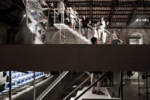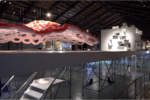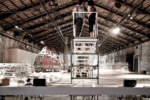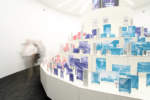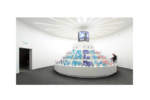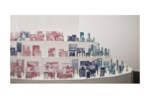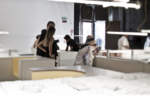year: 2010
An exhibition in progress
Of all the national pavilions participating in this year’s Twelfth International Architecture Exhibition of the Venice Biennial, the Italian one, curated by Luca Molinari, has undoubtedly been among those which have followed the program of Kazuyo Sejima, put in a nutshell by the efficient slogan People meet in architecture, most closely. The famous Japanese architect, director of the last Architecture Biennial, author of buildings inspired by a sophisticated formal and constructive asceticism, intended to counter, with an exhibition far removed from the umpteenth media-oriented self-celebration of the architects who are most active on an international level, the transformation of architecture from an art aimed at building the city as a collective fact, to the parallel and in the final analysis secondary sphere of industrial design, where high-performance and ephemeral landmarks are ideated. Rejecting the media-oriented tendency characterizing the architecture of the last few years, Kazuyo Sejima has thus wanted to once more call the attention of professionals and the general public to the more authentic and lasting aspects of architecture, once again accentuating the central issues of living. Endorsing this programme, Luca Molinari has planned and arranged a simple and essential exhibition which, in spite of the positively hermetic title of Ailati. Reflections from the future, has facilitated the reading of the visitors of the Italian Pavilion, with very clearly stated arguments and, at the same time, an evident and appreciable complexity. The difficult Italian situation has been divided, as if with a crystal prism, into large theme areas, developed in the three distinct areas of the Pavilion. The first is Amnesia of the present. 1990-2010, a “historical-critical attempt to reread – as the curator writes – the last twenty years of our architectural history.
A kind of curious black hole – he asserts with a certainly fascinating metaphor – where histories and phenomena that are crucial for understanding also the current situation cross each others’ paths”. The second area is called Workshop Italy. As Luca Molinari explains, it has been “constructed by selecting only works built in the last few years, intentionally leaving out all projects which are still on paper or await their future”; it has centred almost exclusively on works produced by architects aged between forty and fifty, incidentally drawing an exhaustive and accurate balance of their production. The most interesting figures of this generation, a term which is not intended strictly in terms of age, who have distinguished themselves comprise Archea Associati, Cherubino Gambardella and Simona Ottieri, Labics, ma0, Metrogramma, Italo Rota, Beniamino Servino, Elisabetta Terragni, Cino Zucchi. The works are exhibited in the form of drawings and models arranged in horizontal showcases, almost as if to suggest the dimension of a worktable packed with projects, reveal the essential traits, beyond more personal connotations, of these youths.
wOpen, cooperative, post-ideological, oriented towards internationally nomadic horizons, informed, dissociation with the theme of identity, so dear to the architects who have preceded them, no great appreciation for continuity, indeed, a quite recognizable orientation in favour of discontinuity, far from the dimension of history, the architects who appear in the Italy Pavilion, the Erasmus Generation, which has taken form principally through the web – prove that they vaunt an appreciable ability to identify, in architectural opportunities that are often negligible in terms of scale, the design problem to solve and the institutional representational aspects, a way to influence a reality where the quality of the architectural sign is combined with the attainment of the primary social goals. The third area, which features the demanding title of Italy 2050, has been dedicated to a projection of Italian architecture in the future. Fourteen architects have been invited to “experiment freely – also here we are quoting the young Milanese historian and critic – on the potentially universal themes which may be influential in our country during the forthcoming decades, obliging our architecture to make the effort necessary to yet again challenge a part of its instruments”.
Compared to the objective interest of the first two areas, the third suffers from some problems in terms of content. Defining a kind of duality, which has also been underscored by the exhibition design, between the present time and the future which may be inferred from that present, a kind of theoretical and operative split has been staged. To some extent, what has been achieved at the cost of a true creative adventure and at the price of an often heroic dedication to one’s profession, cannot but appear inadequate with respect to what appears on a remote horizon, prefigured as more free and experimental. Separating realism from utopia may in some ways entail the denial of that utopia of reality which has been the distinctive trait of the best Italian architecture. In actual fact, the visionary character of the installations, also physically positioned in an idealized superior world as compared to the everyday reality, identified with the ground floor, has run the risk of obscuring the value of the contemporary experiences with its indisputable conceptual and visual seductiveness. To be even more explicit, it must be recognized that, as far as Italian architecture is concerned, the reflection on the future has always been associated with a strong unease with respect to the present. In this sense the future may take the form – and in this case this has very nearly been the case – of a kind of reparation and at the same time of evasion. While this by no means invalidates the prefigured realities suggested by the fourteen invitees, it undoubtedly comes to give them a significance that is partially undermined by an alarming feebleness. Apart from remaining in the memory of those who have ventured among the showcases, observing the fascinating diorama of the most important architectural images from the last twenty years in the ellipse, associated with a series of interviews; who have discovered, after climbing the steep stairs, the idealized superior world mentioned in the foregoing, the exhibition ideated by Luca Molinari – an exhibition that is structurally in progress – is documented by a sober and exhaustive catalogue. It is a matter of a simple and complete volume, which is not just a useful recognition of the best proposals offered by the architecture culture of the most active generation, but which, in the Lemmas section, also and most importantly, represents a compendium of highly topical theoretical issues. The catalogue thus becomes a variegated text whose effects on the disciplinary debate will not be limited to witnessing the event in Venice, but will produce more durable and profound effects. In the final analysis, with the exhibition and the catalogue the curator has succeeded in defining a historical and critical perimeter, that is problematic and narrative, within which the current Italian architecture appears as an enigmatic and stratified entity, an entity with a transitive condition, that is advancing in the direction of less incidental and temporary situations, in which one even perceives a certain premonition of happiness.
Franco Purini
Rome, 27/10/2010
Amnesia nel presente
Un excursus dall’ultima fase di lavoro di alcuni grandi maestri del secondo dopoguerra (Ignazio Gardella, Ettore Sottsass jr., Aldo Rossi, Bruno Zevi, Vico Magistretti, Michele Capobianco, Pasquale Culotta) all’esordio della cultura digitale e di due nuove generazioni di architetti, dall’affermazione di alcune grandi firme italiane all’estero come Renzo Piano, Massimiliano Fuksas, Vittorio Gregotti, Aldo Rossi, Paolo Portoghesi, Franco Purini, alla crescita di un’architettura vitale e contemporanea nella provincia italiana.
Laboratorio Italia
Ma0 / Emmeazero Studio D’architettura- Ketty Di Tardo, Alberto Iacovoni, Luca La Torre, Alessandro Scandurra, Scandurrastudio, Archea Associati, Guidarini & Salvadeo, C+S Associati, Francesco Jodice, Cino Zucchi Architetti con Gueltrini e Stignani Associati, Modus Architects, Matteo Scagnol - Sandy Attia, Esterni, Ifdesign, Marina Ballo Charmet, Studio Elementare, Kconsult, Sauerbruch+Hutton, Scandurrastudio, Studio Italo Rota & Partners, Studio Valle Architetti Associati, Cino Zucchi Architetti Con Zucchi & Partners, Canali Associati Srl, Chalers Jencks Con Andreas Kipar - Land Srl, Architettura e Ingegneria Arup Italia, Topotek1, Mab Arquitectura - Massimo Basile, Floriana Marotta, Riccardo Vannucci_farestudio, Studio Tamassociati (Raul Pantaleo, Simone Sfriso, Massimo Lepore), con Pietro Parrino e Gino Strada, Santo Giunta, Orazio La Monaca, Leonardo Tilotta, Simone Titone, Christoph Mayr Fingerle, Lelli & Associati Architettura/Cristofani & Lelli Architetti, Cherubino Gambardella, Greppi&Bianchetti StUdio, Diverserighestudio, Italo Rota con Fabio Fornasari, Renzo Piano e Alessandro Traldi e Maurizio Milano, Renato Rizzi con Barbara Borgini, Dap Studio/ Elena Sacco – Paolo Danelli, Cherubino Gambardella e Simona Ottieri, Amdl Michele De Lucchi, Elasticospa – Stefano Pujatti Architetti, Markus Scherer con Walter Dietl, Emanuele Fidone, Davide Vargas, PiuarcH Partners, Beniamino Servino, Attilio Stocchi, Pietro Carlo Pellegrini, Elisabetta Terragni - Studio Terragni Architetti, Gruppe Gut Snc, Jeffrey T. Schnapp - Stanford Humanities Lab, Filmwork Srl, Franco Purini, La Fabbrica del Sole, Modourbano Architettura, Exergy, Marco Navarra, Claudia D‘Aita ed Enrico Sgarbi, Filippo Romano e Eva Frapicini, Cino Zucchi Architetti + Park Associati, Labics, Vincenzo Latina.
Italia 2050
Fabri Fibra / Anna Barbara, Alessandro Galli / Ecologicstudio, Davide Oldani / Duilio Forte, Leandro Agrò / Gambardella e Ottieri, Tommaso Tessarolo / Ian+, Marzia Lazzerini / Ma0, Nico Vascellari / Marc, Gianni Biondillo / Metrogramma, Emilia Visconti / Marco Navarra_nowa, Francesco Stellacci / Carlo Ratti, Chiara Bonini / Italo Rota, Ilaria Capua / Alessandro Scandurra,
Susanna Nicchiarelli / Beniamino Servino, Achille Stocchi / Attilio Stocchi
Franco Purini was curator of the exhibition "Italia-y- 2026. Invito a Vema" in the Italian Pavilion of the 10th International Architecture Exhibition of Venice Biennale 2006. He is professor of Architectural Design and Urban Design at the Valle Giulia Faculty of Architecture in Rome and Director of the Department of Architecture and Construction.



